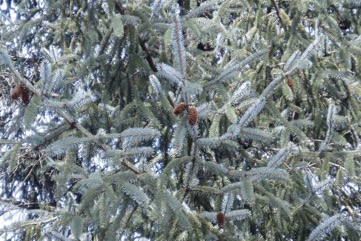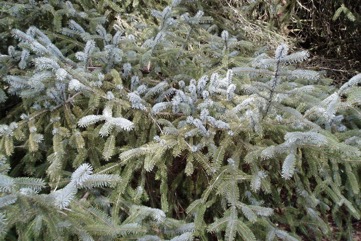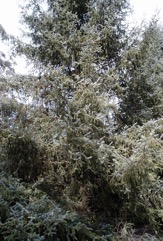Sitka spruce, Coast spruce, Tideland spruce, Alaska spruce

It is a temperate plant. It grows in the foggy zone along the Pacific coast in Canada and USA. It grows inland for 150 km and to about 500 m altitude. It suits wetter places. It suits hardiness zones 4-8. Arboretum Tasmania. Mt Lofty Botanical Gardens.
Edible Portion
- Flowers, Gum, Inner bark, Seeds, Seedspod, Tea, Shoots
Where does Sitka spruce grow?
Found in: Australia, Britain, Canada, Europe, Falklands, Faroe Islands, Germany, Iceland, North America, Slovenia, Tasmania, United States
Notes: There are between 30 and 40 species of Picea.
Growing Sitka spruce, Coast spruce, Tideland spruce, Alaska spruce
Cultivation: Plants are grown by seed.
Edible Uses: The sap or pitch is chewed like chewing gum. It can also be boiled. The inner bark is cooked and dried and stored for later use. The buds are used for food. The young shoots are eaten raw.
Production: Trees live for 700-800 years.
Nutrition Info
per 100g edible portion| Edible Part | Energy (kcal) | Protein (g) | Iron (mg) | Vitamin A (ug) | Vitamin c (mg) | Zinc (mg) | % Water |
|---|---|---|---|---|---|---|---|
| - | - | - | - | - | - |
Sitka spruce, Coast spruce, Tideland spruce, Alaska spruce Photos



References
Coombes, A.J., 2000, Trees. Dorling Kindersley Handbooks. p 65
Cundall, P., (ed.), 2004, Gardening Australia: flora: the gardener's bible. ABC Books. p 1042
Farrar, J.L., 1995, Trees of the Northern United States and Canada. Iowa State University press/Ames p 98
Grandtner, M. M., 2008, World Dictionary of Trees. Wood and Forest Science Department. Laval University, Quebec, Qc Canada. (Internet database http://www.wdt.qc.ca)
Harris, E & J., 1983, Field Guide to the Trees and Shrubs of Britain. Reader's Digest. p 236
Hibbert, M., 2002, The Aussie Plant Finder 2002, Florilegium. p 233
http://www.botanic-gardens-ljubljana.com/en/plants
Kermath, B. M., et al, 2014, Food Plants in the Americas: A survey of the domesticated, cultivated and wild plants used for Human food in North, Central and South America and the Caribbean. On line draft. p 656
Kuhnlein, H. V. and Turner, N. J., 1991, Traditional Plant Foods of Canadian Indigenous Peoples. Food and Nutrition in History and Anthropology Volume 8. Gordon and Breach. p 36
Lord, E.E., & Willis, J.H., 1999, Shrubs and Trees for Australian gardens. Lothian. p 86
MacKinnon, A., et al, 2009, Edible & Medicinal Plants of Canada. Lone Pine. p 30
Marinelli, J. (Ed), 2004, Plant. DK. p 147
Moerman, D. F., 2010, Native American Ethnobotany. Timber Press. p 401
Plants for a Future database, The Field, Penpol, Lostwithiel, Cornwall, PL22 0NG, UK. http://www.scs.leeds.ac.uk/pfaf/
Traite gen. conif. 260. 1855
Turner, N., 1995, Food Plants of Coastal First Peoples. Royal BC Museum Handbook p 32
Upson, R., & Lewis R., 2014, Updated Vascular Plant Checklist and Atlas for the Falkland Islands. Falklands Conservation and Kew.